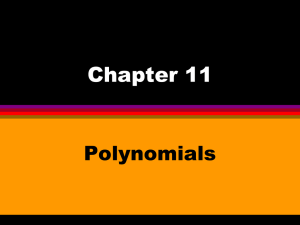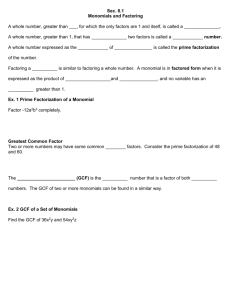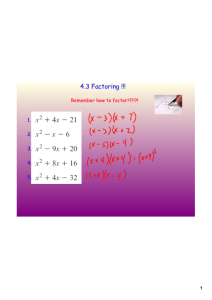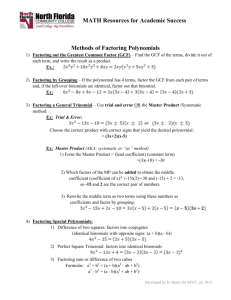Chapter 5: Polynomials 5.1 Multiplying Polynomials Recall that a
advertisement
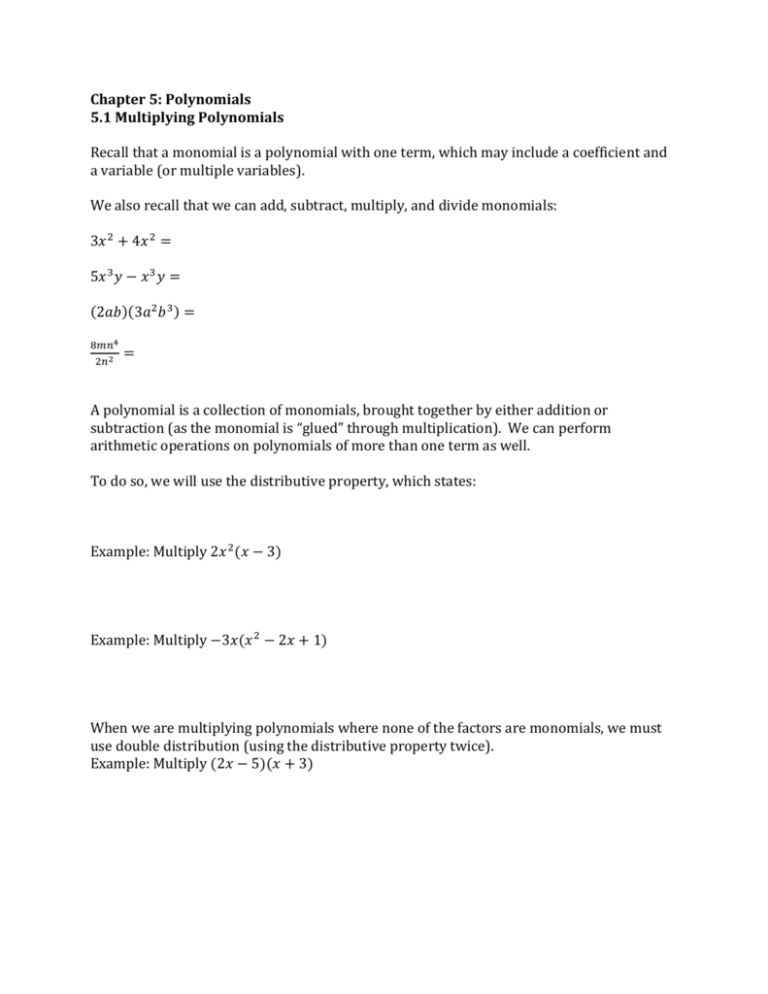
Chapter 5: Polynomials 5.1 Multiplying Polynomials Recall that a monomial is a polynomial with one term, which may include a coefficient and a variable (or multiple variables). We also recall that we can add, subtract, multiply, and divide monomials: 3𝑥 2 + 4𝑥 2 = 5𝑥 3 𝑦 − 𝑥 3 𝑦 = (2𝑎𝑏)(3𝑎2 𝑏 3 ) = 8𝑚𝑛4 2𝑛2 = A polynomial is a collection of monomials, brought together by either addition or subtraction (as the monomial is “glued” through multiplication). We can perform arithmetic operations on polynomials of more than one term as well. To do so, we will use the distributive property, which states: Example: Multiply 2𝑥 2 (𝑥 − 3) Example: Multiply −3𝑥(𝑥 2 − 2𝑥 + 1) When we are multiplying polynomials where none of the factors are monomials, we must use double distribution (using the distributive property twice). Example: Multiply (2𝑥 − 5)(𝑥 + 3) We note that in this process of double distribution, each monomial in the first factor was multiplied by each monomial in the second factor. This leads us to a “shortcut” method for binomial multiplication, using the acronym FOIL: (𝑎 + 𝑏)(𝑐 + 𝑑) Example: Multiply (𝑥 − 3)(𝑥 − 5) We can also take the principle further and multiply higher-order polynomials. Example: Multiply (𝑥 + 2)(𝑥 2 − 2𝑥 + 3) When there are multiple operations being performed on polynomials, we must remember to follow the order of operations. Example: Simplify (𝑥 − 1)(𝑥 + 2) + (𝑥 + 4)(𝑥 + 1) Example: Simplify (2𝑥 − 3)(𝑥 + 1) − 𝑥(𝑥 + 2) Homework: textbook pages 209-213, #3-7, 12, 18, 19 Chapter 5: Polynomials 5.2 Common Factors Given two or more terms, a common factor is a factor that is shared by all of the terms. The greatest common factor is the largest such factor. We can determine the greatest common factor (GCF) between terms by using prime factorization. For each prime factor, we will be limited by the least number of times that factor appears. Example: Determine the GCF of 28 and 20. Example: Determine the GCF of 18000 and 34020. When variables are present, they are considered to be prime as their values can vary. Example: Determine the GCF of 72𝑥 2 𝑦 5 and 162𝑥 3 𝑦. Example: Determine the GCF of 4𝑎𝑏𝑐 3 and 16𝑎2 𝑐 A common multiple of some terms is a one that each term is a factor of. The least common multiple (LCM) is the least such number. Since each factor in the prime factorization must appear a minimum number of times in the least common multiple, we now take the largest number of appearances of each factor as part of our LCM. Example: Determine the least common multiple of 28 and 20. Example: Determine the least common multiple of 72 and 108. Example: Determine the least common multiple of 72𝑥 2 𝑦 5 and 162𝑥 3 𝑦. Example: Determine the least common multiple of 2𝑎2 𝑏𝑐 3 , 2𝑎𝑏𝑐, and 3𝑎𝑏 4 . With common factors we can sometimes factor polynomials. In doing so, we factor out the GCF, and what remains will be the quotient between each monomial and the GCF. We note that the number of terms in the polynomial should be the same as the number of terms remaining after it has been factored. Example: Factor 4𝑥 3 + 4𝑥 2 + 8𝑥. Example: Factor 2𝑥 4 𝑦 + 8𝑥 5 𝑦 3 − 2𝑥 2 𝑦. Example: Factor 7𝑥𝑦 + 7𝑥𝑧 + 7𝑦𝑧. Example: Factor 27𝑟 2 𝑠 2 − 18𝑟 3 𝑠 2 − 36𝑟𝑠 2 . Homework: textbook pages 220-223, #2-6, 7 (a, b), 8, 12(a, c), 17 Chapter 5: Polynomials 5.2 Factoring Trinomials When we multiplied binomials, we used the FOIL method and the result was a trinomial. It logically follows that there must be trinomials that can be expressed as the product of two binomials. When we multiplied binomials and attained a result in the form 𝑎𝑥 2 + 𝑏𝑥 + 𝑐 (the standard form for a trinomial), we could note: The first terms of each binomial multiplied to produce 𝑎𝑥 2 The last terms of each binomial multiplied to produce 𝑐 We can use this as a basis for factoring trinomials. But how to ensure the middle term is correct? If 𝑎 = 1 in the form 𝑎𝑥 2 + 𝑏𝑥 + 𝑐, we will want factors of 𝑐 that sum to 𝑏. Example: Factor each of the following. 𝑥 2 + 5𝑥 + 6 𝑥 2 + 13𝑥 + 12 𝑥 2 − 2𝑥 − 8 𝑥 2 + 2𝑥 − 8 𝑥 2 − 𝑥 − 20 If 𝑎 ≠ 1, we will want to closely examine factors of the product 𝑎 × 𝑐 that sum to 𝑏. Example: Factor each of the following. 2𝑥 2 + 5𝑥 + 2 3𝑥 2 + 8𝑥 + 4 6𝑥 2 − 5𝑥𝑦 + 𝑦 2 10𝑥 2 − 𝑥 − 3 Finally, when factoring, we should first check for a GCF. Once that is factored out, we can use our other factoring methods. Example: Fully factor each expression below. 3𝑥 3 + 3𝑥 2 − 18𝑥 8𝑥 4 𝑦𝑧 2 − 12𝑥 3 𝑦𝑧 2 − 80𝑥 2 𝑦𝑧 2 Remember that since factoring is the reverse process of multiplication, you can always multiply your factors together to verify your answers. Homework: textbook pages 234-237, #3-10, 13, 18 Chapter 5: Polynomials 5.4 Factoring Special Trinomials Simplify each expression below: (𝑥 + 2)(𝑥 − 2) (𝑥 − 5)(𝑥 + 5) (2𝑥 + 3)(2𝑥 − 3) (𝑥 2 − 4𝑦)(𝑥 2 + 4𝑦) What is special about these particular cases of binomial multiplication? The result is known as a difference of squares. It is called a difference of squares because the two monomials present are square terms, and the operation between them is subtraction. We note that the product (𝑎 + 𝑏)(𝑎 − 𝑏) is equal to 𝑎2 − 𝑏 2 , and we can thus conclude that it is possible to factor: 𝑎2 − 𝑏 2 = (𝑎 + 𝑏)(𝑎 − 𝑏) Example: Determine if each expression below is a difference of squares. If it is, factor. 𝑥2 − 9 25𝑥 2 − 1 8𝑥 2 − 49 36𝑥 4 𝑦 2 − 121𝑦 6 We now look at another case. Simplify each expression below. (𝑥 + 3)2 (𝑥 + 1)2 (2𝑥 − 3)2 (𝑥 − 1)2 The results here are referred to as perfect square trinomials. They are called such because they are produced by squaring binomials. We note that since (𝑎 + 𝑏)2 = 𝑎2 + 2𝑎𝑏 + 𝑏 2 , it logically follows that 𝑎2 + 2𝑎𝑏 + 𝑏 2 factors into (𝑎 + 𝑏)2 . Example: Determine if each expression below is a perfect square trinomial. If it is, factor. 𝑥 2 + 4𝑥 + 4 𝑥 2 − 4𝑥 + 4 9𝑥 2 + 30𝑥 + 25 4𝑥 2 + 9 9𝑥 2 + 30𝑥 − 25 Note that general factoring practices still apply – check for a GCF first, then use other factoring methods. Homework: textbook pages 247-251, #2-8, 11, 16, 19, 20, 26 Chapter 5: Polynomials Review Textbook review: Pages 252-253, #2-7, 9, 11-15 Additional questions: None at this time.

